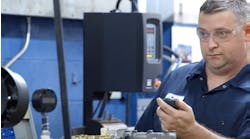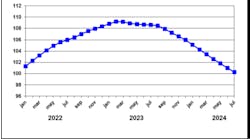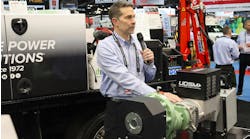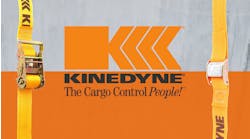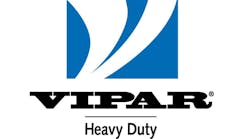How do you know it’s time for a new chamber? Many problems can be easily noticed during pre-trip air system tests and visual inspections: Audible air leaks around the chamber; missing parts such as dust plugs, caging bolts, and clamp bands; or obvious damage to the chamber.
“Look for visual damage to the chamber, such as dents, corrosion, and bent pushrods. Missing dust plugs or loose band clamps can allow contaminants such as water and dirt to get inside the chamber, increasing the chances of corrosion on the power spring or pressure plate, and affecting the brake diaphragm as well,” said Kevin Pfost, technical service coordinator, Bendix Spicer Foundation Brake.
Routine maintenance checks can also point to a chamber in need of replacement—like signs of a dragging brake, including continuous marking on an air disc rotor or hot spots on a drum brake.
Putting things in place
Like-for-like replacement is key: Selecting a chamber with a different pushrod length than the OE specification may not create noticeable short-term problems, but over time, the difference in application force will lead to braking performance issues and, potentially, pushrod failure. If you’re working on a drum brake, determine whether the brake assembly is using a 5.5-inch or 6-inch slack adjuster. The mounting bracket includes holes to position the chamber correctly for either slack length, so it’s important to place it in the proper chamber mounting holes.
“Always remember to empty all primary and secondary air tanks before working on the brake assembly,” Pfost said. “If you see structural damage to a spring brake chamber, do not mechanically release (uncage) the spring. It’s also helpful to take a moment before removing the old chamber to note the bolt and port locations and orientations. This will make installation and orientation of the new chamber easier.”
A note on installing spring brake chambers for parking brakes: Make sure the new chamber’s power spring is caged, so it’s not putting pressure on the pushrod during installation.
After the old chamber is removed, be sure the mounting surfaces are clean and undamaged. Fit the new chamber to the bracket, then secure it with the mounting hardware—always use the new hardware included with the new chamber. Once the chamber is in place, torque the nuts to 144 ±11 ft-lbs.
On a drum brake, the next step is adjusting the slack straight into the clevis on the pushrod and lining up the large clevis pin holes. This permits some up-and-down movement if it’s needed to insert the clevis pin. Once the large pin is in place, push up on the bottom of the small adjuster link and back off the slack to re-engage the link. Then line up the small clevis pin holes on the link and install the small pin. Back the adjuster off a bit to bring the adjusting rod down, lining it up to place the small pin. If the small pin doesn’t line up with the placement holes easily, the adjuster can be adjusted up or down to ease the process.
Fix the large and small clevis pins in place using the washers sized for each, and secure them with cotter pins. Remember to use pliers and bend the “ears” on each of the cotter pins to prevent them from slipping out. The brake can now be adjusted to the proper specs according to the chamber size.
Air line hookup and chamber clocking
At this point, the chamber can be connected to the air supply. If the chamber port is in the proper position for air line hookup, make the connection, pressurize the chamber, and check the fittings for leaks using a soapy water mixture. Once it checks out leak-free, release the air off the chamber and adjust the brakes to the proper stroke. For chamber size and CVSA/DOT recommendations, refer to BW7258 in the online Bendix Document Library at www.bendix.com.
If the chamber port isn’t in the right place to receive the airline, the cover/spring brake chamber will need to be “clocked,” or rotated into position.
Without an air supply, the pushrod will need to be pried into the applied position using a pry bar. After doing so, clamp a vise grip onto the pushrod at the base of chamber to hold it in position.
Next, loosen the service-side clamp bolts on the chamber cover. With the bolts removed, the clamp will loosen, and can be hung over the chamber cam—out of the way, but easily reachable when it’s time to replace it.
Now, rotate the chamber cover into a position where the air supply line can meet the port and fit snugly without stretching or kinking the hose. Do not secure the hose yet; simply check to make sure the port is in the proper orientation.
Once it’s in place, hold the cover and diaphragm in position over the chamber base. Remount the clamp, checking during the process for a good seal all the way around, without the diaphragm being exposed on one side more than the other. When tightening the clamp, alternate the process between the top and bottom bolts to tighten them evenly, and torque them to 25 ±5 ft-lbs.
The air line can now be attached to the fitting. Apply service pressure to let the pushrod come loose, and release the vise grips. Spray the area around the band clamp and hose fittings with a soapy water mix to check for leaks, then release the pressure and, if it’s a drum brake, let the slack adjuster return to the released position.
Information in the Bendix Tech Tips seriescan be found at the Bendix On-Line Brake School, www.brake-school.com. For more information on air chamber maintenance and replacement, contact the Bendix Tech Team at 1-800-AIR-BRAKE.


